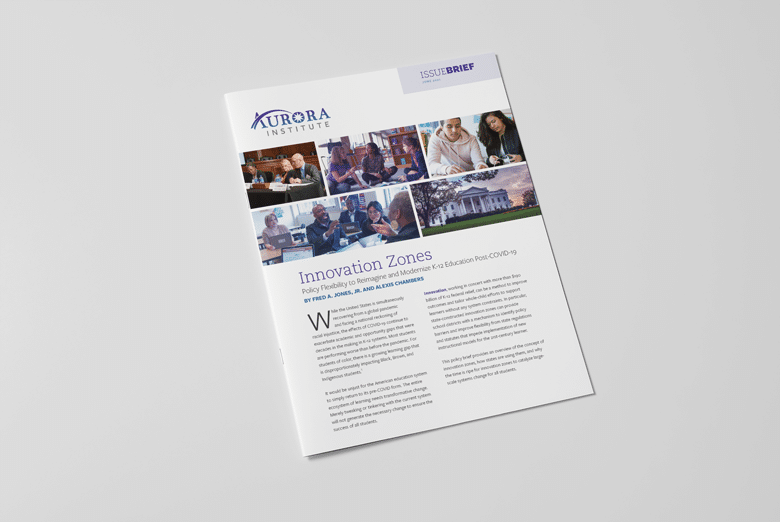States Can Use Innovation Zones as K-12 Reimagines Its Future after COVID
Education Domain Blog
Today, the Aurora Institute Center for Policy published Innovation Zones: Policy Flexibility to Reimagine and Modernize K-12 Education Post-COVID-19, an updated brief examining how 10 states are providing policy flexibility from certain regulations so schools and districts have more freedom to innovate teaching and learning.
Innovation zones represent an important policy lever states can use as K-12 reimagines its future post-COVID. In addition, they represent a single lever that meets the dual demands for racial equity and the exacerbated gaps in learning opportunities that Black, Brown, and low-income learners are facing in the wake of COVID.
The brief is authored by Fred Jones, director, and Alexis Chambers, policy associate, at the Aurora Institute Center for Policy. In addition, the Center for Policy launched a webpage with a map documenting the current landscape of innovation zones and a set of frequently asked questions to guide system leaders considering policy options for systems change in K-12 education.
Innovation zones offer certain flexibilities or exemptions from administrative regulations and statutory provisions that help remove barriers to modernizing education delivery. The term innovation zone, also known as districts of innovation, refers to the idea of creating space for districts and schools to innovate by identifying constraints from current laws and regulations and providing flexibility. In exchange for added flexibility, schools and districts commit to innovating to improve outcomes through re-examining curriculum, instructional approaches, supports, professional development, use of time and talent, and other strategies that meet the unique needs of students and teachers.
The brief looks at how the following states approach innovation zones:
- Arkansas
- Colorado
- Georgia
- Idaho
- Kentucky
- Mississippi
- Montana
- New Hampshire
- South Carolina
- Virginia
More than 25 states have existing innovation zones and are using them to better meet the unique needs of their learners through new instructional models, professional development practices, mastery-based learning, providing flexibility in the use of time and talent, and other strategies.
Innovation zones provide a space for districts to reimagine how the K-12 education system can serve all students, but especially Black, Brown, and students living in low-income households. Despite dramatic improvements in the delivery of education over the last century, the one-size-fits-all, time-based system does not work as well as necessary to ensure that all student subgroups succeed. Innovation zones provide an opportunity to pilot and target innovative new practices and supports that serve the unique needs of student subgroups who have been disproportionately affected by an education system that was not explicitly designed for their academic and emotional health in the first place.
It would be unjust for the American education system to simply return to its pre-COVID form. The entire ecosystem of learning needs transformative change. Merely tweaking or tinkering with the current system will not generate the necessary change to ensure the success of all students. Innovation, working in concert with more than $190 billion of K-12 federal relief, can be a method to improve outcomes and tailor whole-child efforts to support learners without any system constraints. In particular, state-constructed innovation zones can provide school districts with a mechanism to identify policy barriers and improve flexibility from state regulations and statutes that impede implementation of new instructional models for the 21st-century learner.
Download the brief and share: https://aurora-institute.org/resource/innovation-zones-policy-flexibility-to-reimagine-and-modernize-k-12-education-post-covid-19/.
